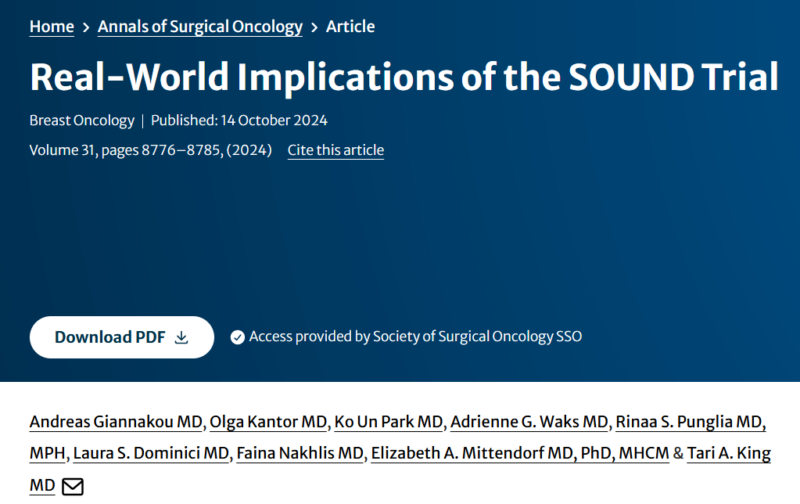A paper by Andreas Giannakou et al. was published in Annals of Surgical Oncology, titled:
“Real-World Implications of the SOUND Trial”
Authors: Andreas Giannakou, Olga Kantor, Ko Un Park, Adrienne Waks, Rinaa Punglia, Laura Dominici, Faina Nakhlis, Elizabeth Mittendorf and Tari King.

Subset Analysis of SOUND-Eligible Cohort by Menopausal Status
Among 199 postmenopausal patients, 178 (89%) were node-negative by sentinel lymph node biopsy (SLNB). Recurrence Score (RS) testing was performed in 101 (50.7%), including 80 node-negative and all 21 node-positive cases. Among node-negative patients, 16 (20%) had RS ≥ 26, and 11 (69%) received chemotherapy. In the node-positive group, three (14.2%) had RS ≥ 26, and all received chemotherapy.
Only two (1.0%) postmenopausal patients had ≥4 positive lymph nodes, both with RS ≤ 25 and not receiving chemotherapy. Among 113 premenopausal patients, 96 (85%) were node-negative. RS testing in 17 node-positive cases revealed all had RS < 26; 76.5% received ovarian suppression and endocrine therapy, while 11.7% received chemotherapy.
SLNB Omission and Treatment Implications
In this real-world SOUND-eligible cohort with cT1N0 HR+HER2− breast cancer, nodal disease burden closely matched the SOUND trial SLNB arm (87.8% vs. 84.6% node-negative). Axillary ultrasound (AxUS) had a false-negative rate (FNR) of 7.3%, comparable to SLNB’s 10% FNR, supporting its role as a staging alternative in postmenopausal patients.
Systemic therapy decisions were primarily guided by RS rather than nodal status, aligning with RxPONDER trial findings, where chemotherapy did not improve survival in postmenopausal patients with RS ≤ 25. In contrast, chemotherapy improved invasive disease-free survival (iDFS) and overall survival (OS) in premenopausal patients with 1–3 positive nodes and RS ≤ 25, reinforcing the need for nodal staging in this subgroup.
Balancing Axillary Staging and Radiation Therapy
SLNB omission is well-supported in women ≥70 years with HR+HER2− cT1N0 tumors, but its impact on radiation therapy (RT) decisions remains a concern. While CALGB 9343 showed RT omission was safe in clinical T1N0 patients, trials such as PRIME II required negative nodal status.
Additionally, hypofractionated RT and partial breast irradiation (PBI) guidelines often require axillary staging. Future research should refine patient selection for SLNB omission, ensuring it does not compromise oncologic outcomes or limit RT options.
